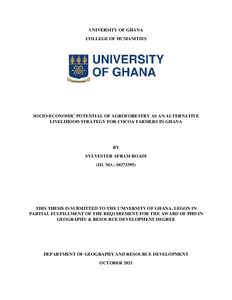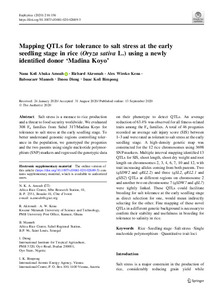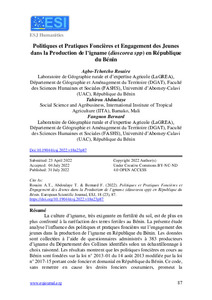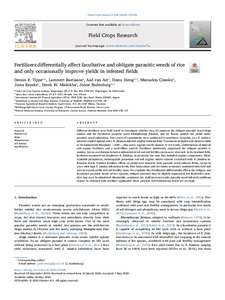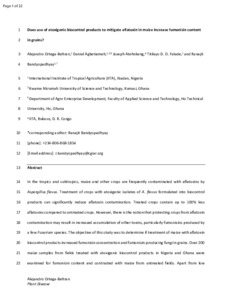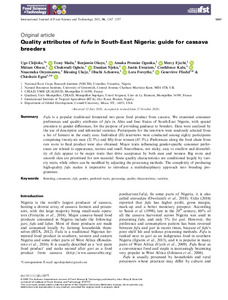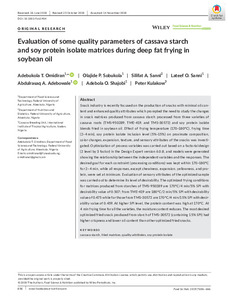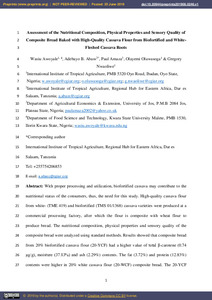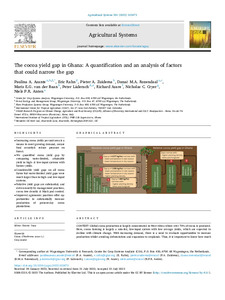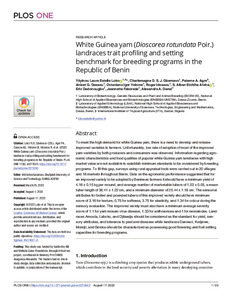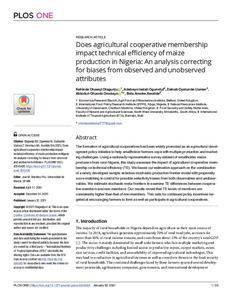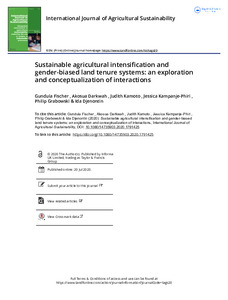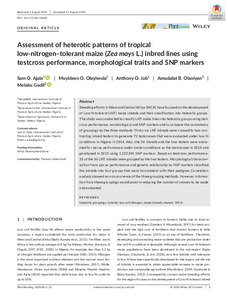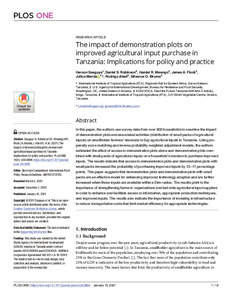Welcome to the International Institute of Tropical Agriculture Research Repository
IITA Bibliography System: Recent submissions
Now showing items 901-920 of 8099
-
Socio-economic potential of agroforestry as an alternative livelihood strategy for cocoa farmers in Ghana
(University of Ghana, 2021-10)Cocoa (Theobroma cacao) cultivation in Ghana is dominated by smallholder farming households most of whom derive the greater percentage of their incomes from the crop. Changes in climate in addition to inherent boom-and-bust cycles associated with cash cropping is reducing the yielding capacity of cocoa plots and, by extension, household incomes. Current research suggests that the integration of trees and other crops into cocoa plots has the potential to increase the resilience of these farms to ... -
Mise en oeuvre des plateformes d'innovation: cas du project CDAT
(IInternational Institute of Tropical Agriculture, 2021-11) -
Mapping QTLs for tolerance to salt stress at the early seedling stage in rice (Oryza sativa L.) using a newly identified donor ‘Madina Koyo’
(2020)Salt stress is a menace to rice production and a threat to food security worldwide. We evaluated 308 F4 families from Sahel 317/Madina Koyo for tolerance to salt stress at the early seedling stage. To better understand genomic regions controlling tolerance in the population, we genotyped the progenies and the two parents using single nucleotide polymorphism (SNP) markers and regressed the genotypic data on their phenotype to detect QTLs. An average reduction of 63.4% was observed for all fitness-related ... -
Politiques et pratiques foncieres et engagement des jeunes dans la production de l'igname (dioscorea spp) en Republique du Benin. Land policies and practices and youth engagement in yam (dioscorea spp) production in the Republic of Benin
(2022)La culture d’igname, très exigeante en fertilité du sol, est de plus en plus confronté à la raréfaction des terres fertiles au Bénin. La présente étude analyse l’influence des politiques et pratiques foncières sur l’engagement des jeunes dans la production de l’igname en République du Bénin. Les données sont collectées à l’aide de questionnaires administrés à 383 producteurs d’igname du Département des Collines identifiés selon un échantillonnage à choix raisonné. Les résultats montrent que les ... -
Fertilisers differentially affect facultative and obligate parasitic weeds of rice and only occasionally improve yields in infested fields
(2020-09-01)Different fertilisers were field tested to investigate whether they (1) suppress the obligate parasitic weed Striga asiatica and the facultative parasitic weed Rhamphicarpa fistulosa, and (2) favour rainfed rice yields under parasitic weed infestation. Four years of experiments were conducted in southwest Tanzania, in a S. asiatica-infested rainfed upland and a R. fistulosa-infested rainfed lowland field. Treatments included sole mineral (NPK or Di-Ammonium Phosphate —DAP— plus urea), organic ... -
Does use of atoxigenic biocontrol products to mitigate aflatoxin in maize increase fumonisin content in grains?
(2021-09-07)In the tropics and subtropics, maize and other crops are frequently contaminated with aflatoxins by Aspergillus flavus. Treatment of crops with atoxigenic isolates of A. flavus formulated into biocontrol products can significantly reduce aflatoxin contamination. Treated crops contain up to 100% less aflatoxins compared to untreated crops. However, there is the notion that protecting crops from aflatoxin contamination may result in increased accumulation of other toxins, particularly fumonisins ... -
Quality attributes of fufu in south-east Nigeria: guide for cassava breeders
(2021-03)Fufu is a popular traditional fermented wet paste food product from cassava. We examined consumer preferences and quality attributes of fufu in Abia and Imo States of South‐East Nigeria, with special attention to gender differences, for the purpose of providing guidance to breeders. Data were analysed by the use of descriptive and inferential statistics. Participants for the interview were randomly selected from a list of farmers in the study area. Individual (II) interviews were conducted among ... -
Evaluation of some quality parameters of cassava starch and soy protein isolate matrices during deep fat frying in soybean oil
(2019-02)Snack industry is recently focused on the production of snacks with minimal oil content and enhanced quality attributes which prompted the need to study the changes in snack matrices produced from cassava starch processed from three varieties of cassava roots (TMS‐950289, TME‐419, and TMS‐30572) and soy protein isolate blends fried in soybean oil. Effect of frying temperature (170–180°C), frying time (2–4 min), soy protein isolate inclusion level (5%–15%) on proximate composition, color changes, ... -
A comparative analysis of technical efficiency and profitability of agribusiness and non-agribusiness enterprises in eastern DRC
(2022)The purpose of this study was to determine whether agribusiness could be competitive compared to non-agribusiness employment opportunities in terms of technical efficiency and profitability. We used data collected on all seven operating cassava community processing centers (CCPCs) and 150 comparable non-agribusiness enterprises in South Kivu province. A Data Envelopment Analysis (DEA), as well as cost–benefit ratios and net monthly revenue, were used to examine technical efficiency and profitability. ... -
Assessment of the nutritional composition, physical properties and sensory quality of composite bread baked with high-quality cassava flour from biofortified and white- fleshed cassava roots
(2019-06)With proper processing and utilization, biofortified cassava may contribute to the nutritional status of the consumers, thus, the need for this study. High-quality cassava flour from white- (TME 419) and biofortified (TMS 01/1368) cassava varieties were produced at a commercial processing factory, after which the flour is composite with wheat flour to produce bread. The nutritional composition, physical properties and sensory quality of the composite bread were analyzed using standard methods. ... -
The cocoa yield gap in Ghana: a quantification and an analysis of factors that could narrow the gap
(2022-08)CONTEXT Global cocoa production is largely concentrated in West Africa where over 70% of cocoa is produced. Here, cocoa farming is largely a rain-fed, low-input system with low average yields, which are expected to decline with climate change. With increasing demand, there is a need to evaluate opportunities to increase production whilst avoiding deforestation and expansion to croplands. Thus, it is important to know how much additional cocoa can be produced on existing farmland, and what factors ... -
White Guinea yam (Dioscorea rotundata Poir.) landraces trait profiling and setting benchmark for breeding programs in the Republic of Benin
(2022)To meet the high demand for white Guinea yam, there is a need to develop and release improved varieties to farmers. Unfortunately, low rate of adoption of most of the improved yam varieties by both producers and consumers was observed. Information regarding agronomic characteristics and food qualities of popular white Guinea yam landraces with high market value are not available to establish minimum standards to be considered by breeding programs. To fill this gap, surveys using rural appraisal ... -
Does agricultural cooperative membership impact technical efficiency of maize production in Nigeria: An analysis correcting for biases from observed and unobserved attributes
(2021-01-22)The formation of agricultural cooperatives has been widely promoted as an agricultural development policy initiative to help smallholder farmers cope with multiple production and marketing challenges. Using a nationally representative survey dataset of smallholder maize producers from rural Nigeria, this study assesses the impact of agricultural cooperative membership on technical efficiency (TE). We based our estimation approach on the combination of a newly developed sample selection stochastic ... -
Sustainable agricultural intensification and gender-biased land tenure systems: an exploration and conceptualization of interactions
(2020)How does sustainable agricultural intensification’s (SAI) tenet of increased productivity on the same area of land relate to prevailing gender-biased land tenure systems? How can one conceptualize the interactions between intensified land use and control over land, labour, crops and benefits – and how can equitable outcomes be facilitated? These questions (which have not yet received sufficient attention in SAI research) are explored in this study using a qualitative methodology and a gender-tra ... -
Atoxigenic-based technology for biocontrol of aflatoxin in maize and groundnuts for Tanzania
(2022)Application of biocontrol products containing atoxigenic isolates of Aspergillus flavus to reduce aflatoxin content in crops is an effective strategy for managing aflatoxin in several regions throughout the world. We report the development and validation of two aflatoxin biocontrol products, Aflasafe TZ01 and Aflasafe TZ02, for use in maize and groundnut in Tanzania, a country frequently affected by aflatoxin contamination. Each product contains four atoxigenic A. flavus genotypes native and widely ... -
Assessment of heterotic patterns of tropical low-nitrogen–tolerant maize (Zea mays L.) inbred lines using testcross performance, morphological traits and SNP markers
(2020-12)Breeding efforts in West and Central Africa (WCA) have focused on the development of Low‐N‐tolerant (LNT) maize inbreds and their classification into heterotic groups. This study was conducted to classify LNT maize lines into heterotic groups using testcross performance, morphological and SNP markers and to compare the consistency of groupings by the three methods. Thirty‐six LNT inbreds were crossed to two contrasting inbred testers to generate 72 testcrosses that were evaluated under low‐N ... -
The impact of demonstration plots on improved agricultural input purchase in Tanzania: implications for policy and practice
(2021)In this paper, the authors use survey data from over 800 households to examine the impact of demonstration plots and associated activities (distribution of small packs of agricultural inputs) on smallholder farmers’ decisions to buy agricultural inputs in Tanzania. Using propensity score matching and inverse probability-weighted adjustment models, the authors estimated the effect of access to demonstration plots alone and demonstration plots combined with small packs of agricultural inputs on a ... -
Misperceived quality: fertilizer in Tanzania
(2021-01)Fertilizer use remains below recommended rates in most of Sub-Saharan Africa, contributing to low crop yields and poverty. We explore the role of fertilizer quality. We interviewed fertilizer sellers in an important agricultural region in Tanzania and sampled their fertilizer to establish that the nutrient content of fertilizers is good, meeting industry standards. However, we find farmers’ beliefs to be inconsistent with this reality. Beliefs about adulteration push down farmer willingness-to-pay ... -
Assessing and understanding non-responsiveness of maize and soybean to fertilizer applications in African smallholder farms
(2021-01-01)Use of mineral fertilizers is essential to enhance crop productivity in smallholder farming systems of Sub-Saharan Africa, but various studies have reported ‘non-responsiveness’ where application of inorganic fertilizers does not lead to satisfactory yield gains. This phenomenon is not well defined nor are its extent and causes well understood. In order to close these knowledge gaps, we assessed the effects of commonly recommended nitrogen (N), phosphorus (P) and/or potassium (K) fertilizer inputs ... -
State of ex situ conservation of landrace groups of 25 major crops
(2022)Crop landraces have unique local agroecological and societal functions and offer important genetic resources for plant breeding. Recognition of the value of landrace diversity and concern about its erosion on farms have led to sustained efforts to establish ex situ collections worldwide. The degree to which these efforts have succeeded in conserving landraces has not been comprehensively assessed. Here we modelled the potential distributions of eco-geographically distinguishable groups of landraces ...

